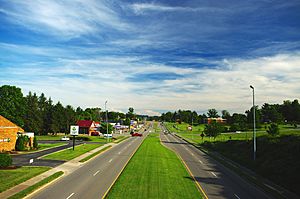Harrogate, Tennessee facts for kids
Quick facts for kids
Harrogate, Tennessee
|
|||
|---|---|---|---|
| City of Harrogate | |||

Businesses in Harrogate along US 25E/SR 32, as viewed from LMU overhead walkway
|
|||
|
|||

Location of Harrogate in Claiborne County, Tennessee.
|
|||
| Country | United States | ||
| State | Tennessee | ||
| County | Claiborne | ||
| Founded | 1888 | ||
| Incorporated | 1993 | ||
| Founded by | Alexander Arthur | ||
| Named for | Harrogate, England | ||
| Government | |||
| • Type | Mayor-council | ||
| Area | |||
| • Total | 7.26 sq mi (18.82 km2) | ||
| • Land | 7.26 sq mi (18.82 km2) | ||
| • Water | 0.00 sq mi (0.00 km2) 0.0% | ||
| Elevation | 1,253 ft (382 m) | ||
| Population
(2020)
|
|||
| • Total | 4,400 | ||
| • Density | 605.64/sq mi (233.85/km2) | ||
| Time zone | UTC-5 (EST) | ||
| • Summer (DST) | UTC-4 (EDT) | ||
| ZIP code |
37724, 37752
|
||
| Area code(s) | 423 | ||
| GNIS feature ID | 2403807 | ||
Harrogate is the biggest city in Claiborne County, Tennessee, United States. It is right next to a cool place called Cumberland Gap National Historical Park.
People have called this place "Harrogate" since the 1800s. But it only officially became a city in 1993. In 2010, about 4,389 people lived there. Harrogate is known as a "college town" because Lincoln Memorial University is right in the middle of it.
Before it was a city, the government counted Harrogate as a special area called Harrogate-Shawanee. In 2000, about 2,865 people lived in this area.
Contents
Harrogate's History and Growth
In 1974, Harrogate's population grew quickly. This led to building a new middle school for students from Harrogate and the nearby town of Cumberland Gap. In 1993, Harrogate officially became a city. It continued to be the fastest-growing place in Claiborne County.
Lincoln Memorial University also grew a lot. New dorms, a sports arena, and new classrooms were built. The university even started a medical program and partnered with a high school in Japan.
Around the late 2000s, the city built a new sewage system. This was important because old septic tank systems were causing problems with groundwater.
Where is Harrogate Located?
Harrogate is located at a specific spot on the map: 36°34′56″N 83°39′25″W / 36.58222°N 83.65694°W.
The United States Census Bureau says the city covers about 7.26 square miles (18.82 square kilometers). All of this area is land.
The community of Shawanee is also located within Harrogate's city limits.
Harrogate's Population Over Time
| Historical population | |||
|---|---|---|---|
| Census | Pop. | %± | |
| 2000 | 2,865 | — | |
| 2010 | 4,389 | 53.2% | |
| 2020 | 4,400 | 0.3% | |
| Sources: | |||
Population Changes in Harrogate
When Harrogate first became a city, its population was around 2,700 people. Since then, the population has grown because the city has expanded its borders. By 2003, the population was estimated to be 3,974. In 2006, it was estimated at 4,425, making Harrogate the largest city in Claiborne County.
Harrogate's Population in 2020
| Race | Number | Percentage |
|---|---|---|
| White (non-Hispanic) | 3,954 | 89.86% |
| Black or African American (non-Hispanic) | 101 | 2.3% |
| Native American | 13 | 0.3% |
| Asian | 41 | 0.93% |
| Pacific Islander | 2 | 0.05% |
| Other/Mixed | 175 | 3.98% |
| Hispanic or Latino | 114 | 2.59% |
In 2020, there were 4,400 people living in Harrogate. There were 1,678 households and 1,039 families.
Education and Culture in Harrogate
Lincoln Memorial University is a private university in Harrogate. It was founded in 1897. The university has a special Abraham Lincoln Library and Museum. This museum has many items related to Abraham Lincoln and the Civil War.
Lincoln Memorial University also has a medical school. It was the first osteopathic medical school in Tennessee.
Public schools in Harrogate include Ellen Myers Elementary, H.Y. Livesay Middle School, and Forge Ridge Consolidated School.
Cumberland Gap High School is also in Harrogate, even though it has a Cumberland Gap address. Tri-State Christian Academy is located there too.
The town has a place called the Daniel Boone Arboretum. It has over 50 different kinds of native trees, all labeled for visitors to learn about.
Sister City
Harrogate has a "sister city" in another country:
See also
 In Spanish: Harrogate (Tennessee) para niños
In Spanish: Harrogate (Tennessee) para niños



